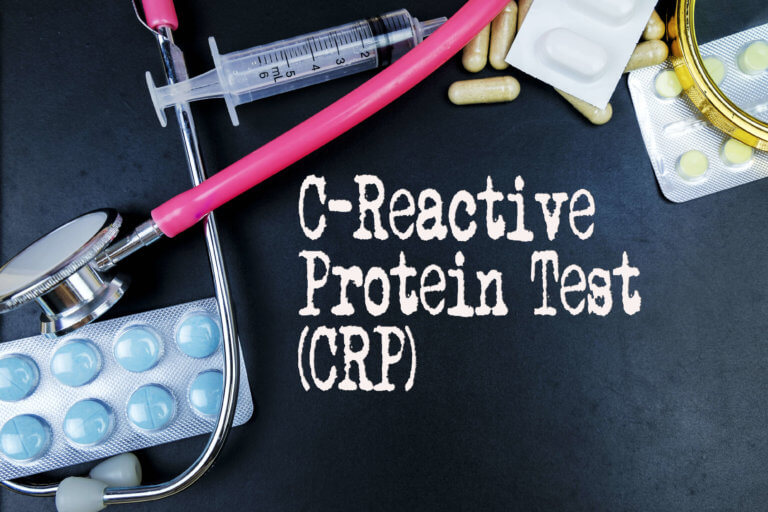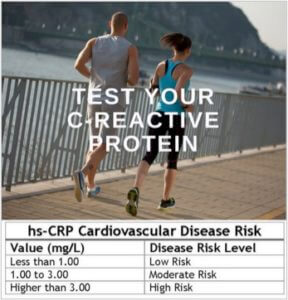Five Reasons Why You Need to Get Your CRP Tested
Knowing if your CRP level is high and how to lower it could save your life.
| | Reading Time: 3 minutes

For my patients, getting tested for C-Reactive Protein (CRP) is as necessary to disease prevention as flossing your teeth or getting your LDL cholesterol level checked. Knowing if your CRP level is high and how to lower it could save your life.
What Is C-Reactive Protein?
C-Reactive Protein (CRP) is a type of protein made in the liver that increases in response to inflammation. It is particularly sensitive to inflammation in the walls of coronary arteries.
Doctors use CRP as a lab marker for evaluating inflammation in the body. CRP is present in the acute phase of infection or inflammation, as well as during chronic inflammation. High levels are diagnostic tip-offs that you may have coronary artery disease, diabetes, or cancer. People with very high CRP are more prone to develop stroke, heart attack, or peripheral vascular disease. CRP is also high in cases of colitis and Crohn’s disease. People with autoimmune conditions like rheumatoid arthritis can also have high CRP.
What Is the Best CRP Test?
There are two tests for C-Reactive Protein:
- CRP Quantitative is a marker in the blood that rises rapidly in response to injury and inflammation. High levels help doctors detect hidden infections and the body’s response to anti-inflammatory therapy. If the therapy is successful, CRP level goes down. The normal range is 0.0 – 4.9 mg/L for LabCorp and 0.0 – 0.8 mg/dL for Quest Diagnostics and ARUP Laboratories.
- CRP highly sensitive (hs-CRP), also termed CRP cardiac, predicts high-risk patients with cardiovascular and peripheral vascular disease. The normal range is 0.00 – 3.00 mg/L.
Order hs-CRP when you get your lipid panel and general health screening blood tests. Since there are no symptoms associated with elevated CRP, you have to get a blood test for hs-CRP to know your level of inflammation.
5 Reasons to Test Your hs-CRP:
- Accurate marker of inflammation
- Targets inflammation in arteries
- Predicts cardiovascular and peripheral vascular disease risk
- Foretell cancer risk
- Predicts metabolic syndrome risk
How to Read your Results
Your hs-CRP results show a scale of relative risk. Less than 1.00 is the best. Over 3.00 is considered high risk. A level over 10.00 is associated with infection and acute inflammation, a marker for unusually high risk for cardiovascular disease.
Cardiovascular and metabolic risk factors tend to cluster. For example: your total cholesterol and LDL may be moderately high, and your HDL a little low. But, if your hs-CRP is elevated, taken together the high hs-CRP magnifies your risk for a heart attack or stroke.

Is There an Optimal Cut Off Point for hs-CRP?
Decades of research went into to the study of CRP. It’s now widely accepted as a predictor of risk for cardiovascular disease and metabolic syndrome, itself a risk factor for heart disease. Most of the studies were compiled mainly in North America and Western Europe. Both are areas of the world with high incidences of obesity, heart disease, metabolic syndrome, and diabetes. CRP is often elevated in all of these conditions.
But what about areas of the world that have lower incidences of cardiovascular disease, like Japan? What about American patients who live a healthy lifestyle and eat a plant-based Asian style or Mediterranean diet?
A Japanese study found that a better cut off point for this patient group may be 0.65 mg/L instead of 1.00 mg/L.
For the average population, the low-risk range of less than 1.0 is acceptable. But, I prefer a tighter range. For my patients, I agree with the Japanese study: an optimal cut off point would be less than 0.65, and close to zero is best.
Test and Retest
Your hs-CRP can be high without any symptoms. That’s why is important to get tested. If your hs-CRP level is high, make lifestyle and dietary changes and retest in six months.


